Is the Flemish Giant rabbit really as sweet as everyone says, or is that just a myth? Should you buy a Flemish Giant or not?
Flemish Giants are the so-called kings of the rabbits because they are so huge. These rabbits can thrive in any weather and they can really impress you through their strength and resilience.
Read the article below to find out more about their origins, care, and health, plus personality myths. Are these rabbits the sweet-natured, docile creatures you will enjoy playing with?
Read on to find out.
Tip: There’s a couple of cute photos in here too, including one of a baby Flemish you’ll fall in love with. Scroll down at your own peril.
Quick Facts/ History
Flemish Giant Rabbits have an interesting history and there is plenty of trivia that helps you understand them better. The other fun facts are well, just fun.
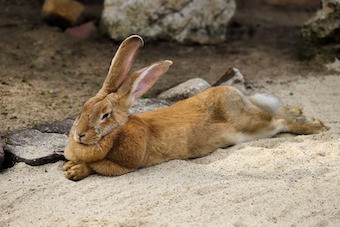
1. These poor bunnies were not bred for their looks
Even if no one can deny it’s fun owning a rabbit as big as a dog, that’s not why Flemish Giant Rabbits were bred in the first place.
Instead, the Flemish Bunnies were the main ingredient of a delicious rabbit stew. This stew was also fairly costly considering that the Flemish Giants need to eat a giant amount of food, so the meals they starred in were not value-for-money.
Another reason for breeding them was their long fur which was used in all sorts of clothing items, such as hats or scarves.
Now, people are mostly interested in Flemish Giants because they are incredibly big and docile. That makes them good pets as well as good show stars.
2. There’s a famous interview with a Flemish Giant called Herbie
The New York Daily interviewed Prospect Park Zoo’s Director, Denise McClean, in 2010. Although the interview was marketed as having been with Herbie, you can read his thoughts as voiced by McClean. Apparently, this gentle giant is so used to living at the zoo, that he would not make it in the wild by himself. His rabbit nature would also make it quite possible to end up with a lot of baby Flemish Giants.
3. Nobody knows where they came from exactly
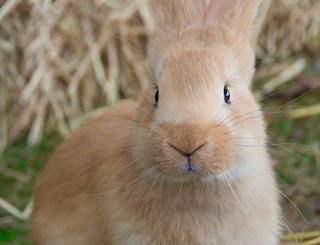
Did you know that rabbit historians are a thing? Well, they are. While they disagree about the precise origins of the Flemish Giants, they can pinpoint the place where these rabbits were first found: Belgium in the 1500s.
Some historians speculate that Flemish rabbits originate from Patagonia, but they all agree that their first official mention is in England’s 1860s.
English travelers and salesmen that were dealing with Flanders in Belgium, were so astounded to see these docile giants that they couldn’t help but bring home all sorts of stories about them.
The Flemish Giants became so popular that they embarked on their first trip to the US in the 1890s.
4. The female Flemish Giant has a unique evolutionary adaptation
The Flemish does possess a unique dewlap, aka some extra chin skin, to keep their kits warm and cozy. This genetic adaptation probably has to do with the colder northern climate in Flanders, a historical part of Belgium.
The advantage for owners is that Flemish Giants are well-suited for any type of weather, and they can even be kept outside unlike dwarf rabbit breeds.
Flemish Giant Rabbit Size & Description
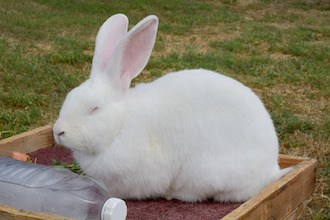
- Length: 2.5 feet maximum
- Weight: 20 pounds (females); 22 pounds (males)
- Head: large with an even shape
- Arch: semi-arch type
- Ears: large and erect in a V-shape on top of their head
- Legs: muscular
- Body: elongated and strong
- Coat colour: several accepted colours; evenly-coloured
- Fur: medium-length, thick and shiny
- Rump: rounded
The Flemish Giants are one of the biggest and heaviest rabbit breeds that have been domesticated, considering their size & weight. While their average weight is 15 pounds, these rabbits can get as big as 2.5 feet and 22 pounds, which puts them on par with a dog.
Curiosity: According to the Guinness Book of Records, the biggest Flemish Giant Rabbit is 4 feet 3 inches. Darius lives in the UK with his human parent, Annette Edwards.
You can also recognize them through their specific mandolin shape because these rabbits have a semi-arch build. The back arch starts just below the shoulders and continues downwards to the tail, hence this unique shape.
Your Flemish Giant will have an elongated, strong body, with large hind legs. You will love petting your Flemish rabbit because its fur is very shiny and thick.
Pro tip: Try some self-hypnosis by petting your Flemish Giant from the hind legs to the head to see how its thick fur rolls back like a wave of fluffiness to its original position.
Although the Flemish Giants have big heads, males have broader heads than females. Don’t forget about the female dewlap she uses to keep her kits warm.
The Flemish Giant comes in seven different colors recognized by the National Federation of Flemish Giant Rabbit Breeders.
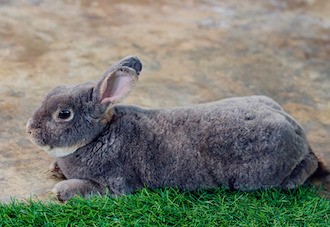
These colors are:
- Black
- Blue
- Fawn
- Light Grey
- Sandy
- Steel Grey
- White
This list progressed from a century ago when the Federation recognized only grey and black. In fact, that’s one of the reasons why Thomas Coatoam, the guy who published all about the Origins of the Flemish Giants in the capital guidebook of the Federation, said these rabbits are “not handsome” and have a “general uncouth appearance.”
Care/Health
It’s important to take care of your pet rabbit. Although these Flemish Giants live an average of 8-10 years, they can live even longer if you take care of them correctly. Conversely, an unloved, uncared-for Flemish Giant will live less and have a decreased life quality.
What’s the right cage for my Flemish Giant?
Flemish Giants need a lot of space, and that can be challenging for a lot of owners who don’t have enough room in their homes or yards.
Flemish Giants are much bigger than usual rabbits, so you can’t buy your average cage on Amazon because it will feel too small for your pet.
That doesn’t mean you have to spend an arm and a leg for a custom-made home for your Flemish bunny. Affordable options are:
- Wide dog crate if you want to keep your rabbit inside.
- An enclosed outdoor cage for outside rabbits.
How does a Flemish Giant play?
Play is an important part of anyone’s life, whether they’re rabbits or humans. Play helps Flemish Giants develop certain skills and follow their natural-born instincts. Play keeps them happy and entertained, which is essential for decreasing their overall stress levels.
Stress is especially rough for rabbits, who develop anxiety-related gastrointestinal issues and immunity problems.
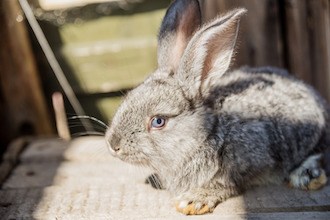
You can help your Flemish Giant play by:
- Adding some toys to its cage
- Attaching a playpen to the cage
- Making a playroom in your house where you can let them out to play
- Attaching a dog kennel to the crate
What do I feed my Flemish Giant?
Healthy food is an important part of a healthy life for your pet rabbit. Just like for other rabbit breeds, they need 70% hay and 30% high-quality pellets, with plenty of freshwater, and a few vegetable snacks. Consider timothy hay and 18% protein pellets as the best options.
You’re also probably asking yourself how much food you should give your Flemish rabbit. The rule of thumb is as much as it needs because rabbits will not overeat out of pleasure or stress.
If you need a better idea, consider about one cup or 1.5 cups of pellets each day.
Pro tip: You will need a lot of stores, so consider getting 50-pound bags of pellets to make sure you have enough. You can also buy cheap hay in a bale.
How often should I clean my Flemish rabbit’s cage?
Flemish rabbits are giants and as such, they poop like giants too. Smaller breeds need a complete changing of their bedding every week, but these Flemish giants need their bedding replaced two to three times per week.
It’s best to spot clean every day, though, to make sure pathogens can’t get a chance to multiply and make your rabbit ill.
How often should I groom my Flemish rabbit?
Flemish rabbits have thick, medium-length fur and, as such, they need to be combed with a soft brush at least once per week outside the shedding season. When they’re shedding, you will have to comb their fur daily.
Cut your rabbit’s fingernails about twice per month with a clipper. It’s best for your vet to do the first nail trimming in front of you, so you can see how long the nails should be.
Health Issues

Flemish Giants are prone to these health issues:
Ear mites and fur mites
It’s because they have thick fur. That’s why it’s a good idea to brush them regularly and to check for mites while you’re doing it
Heat strokes
These rabbits need to be kept cool at all times so turn on the air conditioning in your house, or else place frozen water bottles in their cages for those scorching summer days.
Pododermatitis
This condition is caused by the pressure their weight puts on their hocks, which is why Flemish rabbits need thick and plush bedding.
Spine and joint problems
Flemish rabbits can develop arthritis or spondylosis because they’re so heavy and have a mandolin shape.
Flystrike
Female Flemish Giants are especially prone to this condition because their dewlaps make brushing their back ends more difficult.
Cardiovascular issues
Like most big rabbit breeds, Flemish rabbits are prone to cardiomyopathy possibly because they have bigger calcium levels and lower potassium levels than the norm. Potassium protects the heart, while excess calcium is linked with some thyroid problems that influence cardiovascular health.
Temperament & Personality
Flemish Giants are calm and gentle. They are relaxed and easygoing, and so they make a wonderful pet, whether for an adult or for a child.
Many people buy Flemish Giants because they expect a sweet rabbit they will connect with instantly. Keep in mind that:
- Their background matters. If you’ve purchased your rabbit from a breeder who was a bit rough with it, or if your rabbit has been in several families before you adopted it, it might take a while to connect with it.
- Their instincts matter. Rabbits are prey animals, meaning their instinct is to avoid loud noises, sudden movements, and new situations. Your Flemish might be skittish at first, so don’t try to pick him up out of the blue. Use gentle movements, and allow it to come to you first.
Lifespan, Breeding, and Babies

Flemish Giant Rabbits live an average of 8-10 years, although some sources indicate an average lifespan of 5-10 years.
Unlike some dwarf breeds, these rabbits take twice as much to reach reproductive maturity. Males are considered mature enough to produce babies when they’re 18 months old. Females are more precocious and so they reach maturity at 12 months.
The doe will have a litter of five to twelve baby Flemish Giants. The newborns look like red, bald mice, so you won’t be too impressed. But once they open their eyes around two weeks and start developing their fur along with their appetites at around five weeks, you will fall in love with your Flemish Giant baby.
In Conclusion – Should I Get a Flemish Giant Rabbit?
Flemish Giant Rabbits are some of the sweetest-natured rabbits in the rabbit kingdom. They are lovable, they get along with other pets, including a dog or a cat, and they can be placed in a cage outside.
On the downside, the Flemish Giants need more cleaning and grooming, and they’re prone to several parasites and bone problems.
If you have space and are ready to put in the time to have a happy, healthy Flemish, go for it! And come back here to tell us all about your new pet. The comments are right below.

